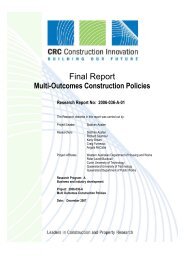2006-07 - Construction Innovation
2006-07 - Construction Innovation
2006-07 - Construction Innovation
You also want an ePaper? Increase the reach of your titles
YUMPU automatically turns print PDFs into web optimized ePapers that Google loves.
5. Commercialisation and Utilisation<br />
<strong>Construction</strong> <strong>Innovation</strong> engages in collaborative research and implementation<br />
for the property, design, construction and facilities management (FM) industry.<br />
It works with industry, government and researchers to improve productivity<br />
and sustainability.<br />
5.1 Commercialisation and utilisation strategies<br />
and activities<br />
<strong>Construction</strong> <strong>Innovation</strong>’s Commercialisation/Technology Transfer<br />
Program is designed to enhance the transfer of research outputs<br />
into commercial or industry outcomes of economic, environmental<br />
or social benefit to Australia.The three guiding principles in achieving<br />
this are:<br />
• to ensure Intellectual Property (IP) management and strategies<br />
for commercialisation are targeted to potential commercial<br />
opportunities<br />
• to transfer public good research outcomes to <strong>Construction</strong><br />
<strong>Innovation</strong> participants, the construction industry and the<br />
broader Australian community<br />
• to ensure that smart and streamlined systems are utilised<br />
to effectively manage research activities in a focused and<br />
targeted manner, allowing easy identification and exploitation<br />
of commercialisation opportunities.<br />
<strong>Construction</strong> <strong>Innovation</strong>’s project agreements address a process<br />
for commercialisation and/or utilisation of the outputs at the<br />
commencement of a project. Each six-monthly project review<br />
considers the commercialisation opportunities with, where<br />
appropriate, a more focused strategy being developed six to nine<br />
months from the completion of the research. Legal and technology<br />
development professionals are engaged, as required, to develop<br />
appropriate licence agreements. Market analysis and economic<br />
impact reports are sourced externally.<br />
To facilitate the management of Intellectual Property and strategies for<br />
commercialisation, <strong>Construction</strong> <strong>Innovation</strong> also educates and trains<br />
key personnel. A workshop was held for students and researchers<br />
in April 20<strong>07</strong> on knowledge IP management and commercialisation<br />
processes.<br />
Trials of project outputs allow participants to become familiar with<br />
tools or processes developed at a project level. Often, the learnings<br />
from projects influence processes within participant organisations. For<br />
example, two of our government agency participants are reviewing<br />
the requirements of their electronic tender and contract administration<br />
procedures to allow appropriate electronic signatures to be used,<br />
electronic contract formations, electronic contract administration,<br />
issues of IP, evidentiary and archive issues. The BRITE project also<br />
encouraged innovation in government agencies and allowed suppliers<br />
and contractors to share risk and develop procurement contracts<br />
which give suppliers and contractors more scope for innovation in<br />
their delivery approach.<br />
Digital technology provides the technology for a virtual information model to be<br />
handed from the design team to the owners. © Sydney Opera House. Courtesy<br />
of Utzon Architects/Johnson Pilton Walker (Architects in collaboration) – Arup.<br />
Our first preference for commercialisation partners are our <strong>Construction</strong><br />
<strong>Innovation</strong> participants. In all projects it is a requirement that there are<br />
at least two research-users. Therefore, potential initial adopters of the<br />
technology are likely to be the industry participants involved early in<br />
the specific project.<br />
The Sydney Opera House has been able to employ knowledge,<br />
processes and tools developed to demonstrate to its stakeholders<br />
that there is the option to increase the effectiveness of their FM<br />
services portfolio. <strong>Construction</strong> <strong>Innovation</strong> research has provided<br />
prototypes and guidelines that will also contribute to the development<br />
of the new 25 year strategic asset management plan, provided a new<br />
model for the ongoing procurement of design works to the current<br />
refurbishment program and insights into the strategic decision making<br />
on digital modelling and the FM tools and systems.<br />
Another example of this approach has been the adoption by John<br />
Holland Group of outputs from our <strong>Construction</strong> Site Safety Culture<br />
project into their safety leadership development activities. John<br />
Holland Group was an active contributor to this project – Dean<br />
Cipolla, John Holland’s Group Safety Manager, led the project.<br />
Additionally, engagement with industry associations in the project<br />
development and delivery strengthens industry pathway to adoption.<br />
In the case of the Sydney Opera House FM Exemplar Project, our<br />
collaboration with the Facilities Management Association of Australia<br />
(FMAA) ensured the FM industry received key project outcomes by<br />
36

















